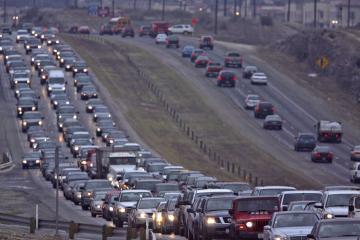 Urban Texas represents the engine of the state’s dynamic economy, as well as our most critical — and most expensive — mobility challenge. But even with funding increases passed in the 2013 and 2015 legislative sessions, resources for vital urban mobility projects fall short.
Urban Texas represents the engine of the state’s dynamic economy, as well as our most critical — and most expensive — mobility challenge. But even with funding increases passed in the 2013 and 2015 legislative sessions, resources for vital urban mobility projects fall short.
To no one’s surprise, congestion in Texas cities continues to worsen. Wasted time, wasted fuel and lost opportunity should concern us all. Texas A&M University’s Transportation Institute recently reported that in 2014, congestion in major Texas cities resulted in drivers wasting more than 274 million gallons of fuel and nearly 612 million extra hours — 43 per driver. Total statewide losses: $14.2 billion.
How can Texas address its urban mobility challenge more quickly while optimizing its limited transportation resources? A proven solution exists. Roughly a decade ago, our Legislature authorized public-private-partnerships, or P3s, enabling the Texas Department of Transportation to leverage limited public funds with private investment to develop our most vital, complex and expensive transportation projects years ahead of conventional methods.
Last week, Texas’ largest and most ambitious P3 project to date, the LBJ Express in Dallas County, opened three months ahead of schedule. The LBJ roadway first opened in 1967; 30 years later it had become synonymous with congestion delays and safety concerns in the minds of area drivers.
After years with no viable solutions, TxDOT’s 2009 award of the project as a P3 model ensured its completion at least a decade earlier than conventional methods.
The competition leading the LBJ project award attracted the most highly accomplished and creative design, construction and financing teams in the world. Notably, it also assured the lowest project cost available.
TxDOT contributed $490 million to the LBJ project, 30 percent less than the $700 million it had reserved for the roadway and only 18 percent of the total project cost.
In exchange, the state receives a $2.7 billion transportation asset with all operating and maintenance costs covered by the operator for the next 50 years. Texas owns the roadway; the operator assumes all design, construction and financial risk — no small benefit considering the project’s size and complexity. Funds that TxDOT saves by minimizing its investment, and eliminating operating and maintenance costs now support other important mobility projects.
LBJ Express represents a total reconstruction of the original roadway to state-of-the-art standards, adding capacity and length to frontage roads that allow drivers to bypass intersections, and providing the choice of dedicated, express toll lanes in each direction for the entire 13 miles of the project that assure minimum speeds no less than 50 mph. The new LBJ Express will transform mobility in and around a corridor vital to one of the most dynamic urban economies in the U.S.
The LBJ Express P3 model is a proven success. The $2.1 billion North Tarrant Express in Tarrant County opened ahead of schedule in October, doubling highway capacity along severely congested corridors.
Texas’ economic success presents urban mobility challenges that demand bold and comprehensive strategies that reduce construction schedules and optimize resources. See for yourself: Drive the LBJ or NTE. The P3 model represents the most powerful mobility strategy available for Texas cities and our expanding urban economy.
To read the full article, click here.